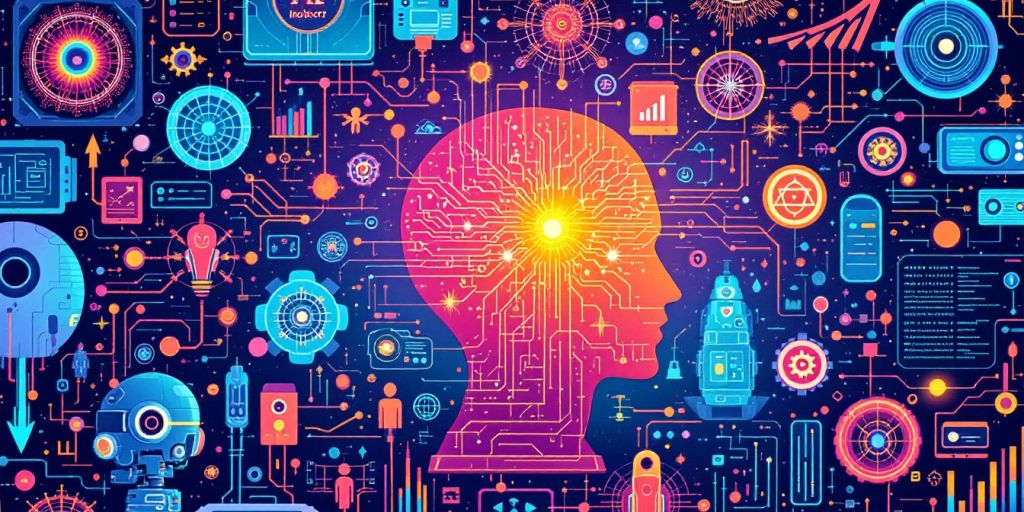As we step into 2024, the world of Artificial Intelligence (AI) is evolving rapidly, transforming how we live and work. This article highlights 30 key statistics and trends that illustrate the significant impact of AI across various sectors. From market growth to consumer concerns, these insights will help you understand the current landscape and future possibilities of AI technology.
Key Takeaways
- The AI market is projected to hit $1,339 billion by 2030, showing massive growth.
- AI is expected to boost the U.S. GDP by 21% by 2030, indicating its economic importance.
- Over 75% of consumers worry about misinformation generated by AI.
- ChatGPT gained 1 million users in just five days after its launch, showcasing rapid adoption.
- By 2030, 10% of cars on the road are expected to be self-driving.
1. AI Market Size Is Expected To Reach $1,339 Billion By 2030
The global AI market is projected to grow significantly, reaching $1,339 billion by 2030. This represents a massive increase from its current estimated value of $279 billion. The growth is driven by various factors, including the rising demand for AI applications in different sectors such as healthcare, automotive, and finance.
Key Growth Drivers:
- Increased Adoption: More businesses are integrating AI into their operations.
- Technological Advancements: Innovations in AI technology are making it more accessible and effective.
- Consumer Demand: There is a growing expectation for personalized experiences powered by AI.
Market Growth Overview:
| Year | Estimated Market Size (in Billion $) |
|---|---|
| 2024 | 214 |
| 2025 | 400 |
| 2030 | 1,339 |
The AI market is expanding rapidly, and its impact on various industries is expected to be profound. Companies that embrace AI will likely gain a competitive edge in the market.
This growth trajectory indicates that AI will not only transform businesses but also reshape the global economy as a whole. As we move towards 2030, the integration of AI into everyday life will become increasingly prevalent, making it a crucial area for investment and development.
2. AI Will Have An Estimated 21% Net Increase On The United States GDP By 2030
AI is projected to add a 21% net increase to the United States GDP by 2030. This growth highlights how AI is becoming a major player in boosting the economy. Here are some key points to consider:
- Economic Growth: AI’s integration into various sectors is expected to drive significant economic growth.
- Job Creation: As AI technologies advance, new job opportunities will emerge, requiring a skilled workforce.
- Increased Efficiency: Businesses adopting AI can expect improved efficiency and productivity, leading to higher profits.
| Year | Estimated GDP Increase (%) |
|---|---|
| 2024 | 5% |
| 2026 | 10% |
| 2030 | 21% |
The rise of AI is not just about technology; it’s about transforming the way we work and live, making it essential for future economic success.
3. Over 75% Of Consumers Are Concerned About Misinformation From AI
A significant 75% of consumers express worries about misinformation generated by AI. This concern highlights the need for transparency and accountability in AI technologies. As AI becomes more integrated into daily life, understanding public sentiment is crucial.
Key Concerns About AI Misinformation
- Trust Issues: Many people feel uncertain about the accuracy of AI-generated content.
- Impact on Decisions: Misinformation can lead to poor choices in areas like health and finance.
- Need for Regulation: There is a growing call for rules to ensure AI is used responsibly.
Consumer Sentiment on AI
| Concern Type | Percentage of Consumers |
|---|---|
| Concerned about misinformation | 75% |
| Trust AI-generated content | 35% |
| Support for AI regulation | 85% |
The rise of AI brings both opportunities and challenges. Addressing misinformation is essential for building trust and ensuring that AI serves the public good.
4. ChatGPT Had 1 Million Users Within The First Five Days Of Being Available
ChatGPT made a huge splash in the tech world by reaching 1 million users in just five days after its launch. This rapid growth shows how much people are interested in AI tools. Here are some key points about ChatGPT’s early success:
- Fast Adoption: ChatGPT’s user base grew quickly, highlighting the demand for AI solutions.
- User Engagement: Many users found ChatGPT helpful for various tasks, from answering questions to generating content.
- Market Impact: The quick rise in users indicates a strong market for AI applications.
| Time Frame | Users |
|---|---|
| Day 1 | 100,000 |
| Day 2 | 300,000 |
| Day 3 | 500,000 |
| Day 4 | 800,000 |
| Day 5 | 1,000,000 |
The success of ChatGPT shows that people are eager to use AI in their daily lives, making it a game-changer in technology.
5. One In 10 Cars Will Be Self-Driving By 2030
By 2030, it is predicted that 10% of cars will be self-driving. This shift is part of a larger trend in the automotive industry, where the market for autonomous vehicles is expected to grow significantly. Here are some key points about this trend:
- The number of self-driving cars is projected to rise from 20.3 million in 2021 to 62.4 million by 2030.
- Major companies are investing heavily in research and development to enhance self-driving technology.
- Consumer acceptance is gradually increasing, although many still have concerns about safety and reliability.
| Year | Projected Number of Self-Driving Cars |
|---|---|
| 2021 | 20.3 million |
| 2025 | 40 million |
| 2030 | 62.4 million |
The future of driving is changing rapidly, with autonomous vehicle trends taking shape in 2024 that will redefine how we think about transportation.
6. 64% Of Businesses Expect AI To Increase Productivity

A significant 64% of businesses believe that artificial intelligence will help increase their overall productivity. This shows a growing confidence in AI’s ability to transform business operations. Here are some key points:
- Streamlining Processes: 42% of businesses think AI will make job processes smoother.
- Concerns About Dependence: 43% worry about relying too much on technology.
- Skill Gaps: 35% are concerned about having the right skills to use AI effectively.
| Concern Type | Percentage |
|---|---|
| Technology Dependence | 43% |
| Lack of Technical Skills | 35% |
| Streamlining Job Processes | 42% |
Many businesses see AI as a way to boost productivity, but they also recognize the challenges that come with it.
Overall, the outlook on AI in the workplace is positive, with many expecting it to enhance efficiency and effectiveness in various tasks.
7. 83% Of Companies Claim That AI Is A Top Priority In Their Business Plans
A significant 83% of companies report that integrating AI into their business strategies is a top priority. This trend highlights the growing importance of AI in shaping the future of business operations. Here are some common ways companies are utilizing AI:
- Automated customer service through chatbots.
- Data analysis for better decision-making.
- Personalized marketing strategies to enhance customer engagement.
As businesses increasingly rely on AI, the demand for skilled professionals in this field is expected to rise. The following table summarizes the current AI usage among companies:
| AI Usage Status | Percentage |
|---|---|
| Fully enabled by AI with widespread adoption | 25% |
| Limited AI use cases implemented | 33% |
| Testing proofs of concept with limited success | 14% |
| Exploring AI options | 7% |
The integration of AI is not just a trend; it is becoming a necessity for companies aiming to stay competitive in their industries.
With the rapid advancements in AI technology, businesses that prioritize AI are likely to see significant improvements in efficiency and productivity.
8. Netflix Makes $1 Billion Annually From Automated Personalized Recommendations
Netflix has become a leader in using AI technology to enhance viewer experience. The streaming service generates around $1 billion each year from its automated personalized recommendations. This system is vital for keeping users engaged and satisfied with their content choices.
Key Points:
- 80% of watch time on Netflix comes from personalized suggestions.
- The recommendation system helps Netflix save significant costs by retaining customers.
- AI-driven recommendations are tailored to individual preferences, making it easier for users to find shows and movies they love.
Netflix’s recommendation system is crucial for its success, as it not only boosts viewer satisfaction but also significantly contributes to its revenue.
Impact of AI on Netflix:
- Increased Engagement: Personalized content keeps viewers watching longer.
- Cost Savings: By retaining customers, Netflix avoids the costs of acquiring new ones.
- Data Utilization: The platform uses viewer data to continuously improve recommendations.
Overall, Netflix’s innovative use of AI in personalization is a key factor in its financial success and customer loyalty.
9. 48% Of Businesses Use Some Form Of AI To Utilize Big Data Effectively
In today’s fast-paced world, nearly half of all businesses are leveraging AI to make sense of their data. This trend highlights the growing importance of AI in helping companies analyze and utilize big data effectively. Here are some key points about AI usage in businesses:
- 56% of companies use AI to enhance their operations.
- 51% rely on AI for cybersecurity and fraud management.
- 47% utilize AI as digital personal assistants.
The following table summarizes the various ways businesses are adopting AI:
| AI Usage Area | Percentage of Businesses Using AI |
|---|---|
| Improve business operations | 56% |
| Cybersecurity and fraud management | 51% |
| Digital personal assistants | 47% |
| Customer relationship management | 46% |
| Inventory management | 40% |
AI is not just a trend; it’s becoming a vital tool for businesses to gain a competitive edge and improve efficiency.
As companies continue to explore AI, they are not just looking for quick fixes but are aiming to enhance customer service, automate processes, and analyze data more effectively. This shift is crucial for staying relevant in a competitive market.
10. 38% Of Medical Providers Use Computers As Part Of Their Diagnosis
In the healthcare field, 38% of medical providers are now using computers to assist in their diagnosis processes. This trend shows how technology is becoming a vital part of medicine. Here are some key points about this shift:
- Improved Accuracy: Computers help doctors make more accurate diagnoses by analyzing large amounts of data quickly.
- Efficiency: Using technology can speed up the diagnosis process, allowing patients to receive care faster.
- Data Utilization: Medical providers can leverage vast amounts of healthcare data to enhance their treatment plans.
| Year | Percentage of Providers Using Computers |
|---|---|
| 2019 | 30% |
| 2020 | 35% |
| 2021 | 38% |
The integration of computers in healthcare is transforming the future of medicine, making it more efficient and effective for both providers and patients.
11. 9 In 10 Organizations Back AI To Give Them A Competitive Edge Over Rivals
In today’s fast-paced business world, nearly 9 in 10 organizations believe AI will provide them a competitive edge. This strong belief highlights the growing importance of AI in shaping business strategies. Here are some key points regarding AI adoption:
- Increased Efficiency: Many companies are turning to AI to streamline operations and reduce costs.
- Enhanced Decision-Making: AI tools help businesses analyze data more effectively, leading to better decisions.
- Customer Personalization: AI allows for tailored experiences, improving customer satisfaction and loyalty.
Despite the enthusiasm, there are challenges to AI adoption. Some of the main obstacles include:
- Lack of Skilled Workers: Many organizations struggle to find individuals with the necessary AI skills.
- Unclear ROI: Companies often find it hard to measure the return on investment from AI initiatives.
- Complexity of Systems: The intricate nature of AI technology can be daunting for businesses.
Understanding the specific needs of clients can help organizations tailor their AI strategies effectively.
As AI continues to evolve, its role in providing a competitive advantage will likely grow, making it essential for businesses to adapt and innovate.
12. 80% Of Retail Executives Expect Their Businesses To Adopt AI Automation By 2025

In the retail sector, 80% of executives believe that their companies will implement AI automation by 2025. This trend shows a strong commitment to integrating technology into business operations. Here are some key points about this shift:
- Increased Efficiency: AI can streamline processes, making operations faster and more efficient.
- Enhanced Customer Experience: Automation can lead to better service, as AI can handle customer inquiries quickly.
- Data-Driven Decisions: AI helps in analyzing customer data, allowing businesses to make informed choices.
| Year | Expected AI Adoption Rate |
|---|---|
| 2023 | 60% |
| 2024 | 75% |
| 2025 | 80% |
The retail and customer products sector will significantly increase AI adoption over the next few years. This shift is not just a trend; it’s becoming a necessity for staying competitive in the market.
13. 57% Of Companies Are In The Exploration Phase Of AI Adoption
As businesses look to the future, 57% of companies are still exploring how to adopt AI technologies. This exploration phase is crucial as it allows organizations to experiment with AI on a smaller scale before fully committing. Here are some insights into this trend:
- Many companies are testing AI in specific departments.
- A significant portion of businesses is conducting limited trials to gauge effectiveness.
- Only a small percentage have fully integrated AI into their operations.
| AI Adoption Stage | Percentage |
|---|---|
| Not using AI but exploring | 7% |
| Limited success with proofs of concept | 14% |
| Promising proofs of concept, looking to scale | 21% |
| Fully enabled processes with AI | 25% |
| Limited AI use cases implemented | 33% |
The exploration phase is essential for companies to understand the potential benefits and challenges of AI before making larger investments.
This cautious approach reflects a broader trend where businesses prioritize understanding AI’s impact on their operations and customer interactions before diving in headfirst. As the landscape evolves, companies that take the time to explore will likely find themselves better prepared for the future of AI integration.
14. 22% Of Firms Are Aggressively Pursuing AI Integration
In 2024, 22% of firms are aggressively pursuing AI integration across various sectors. This shows a strong commitment to adopting AI technologies to enhance their operations and services. Here’s a quick look at how businesses are approaching AI:
- Exploration Phase: 45% of companies are still exploring AI options.
- Limited Implementation: 33% have started using AI in a limited capacity.
- Widespread Adoption: Only 25% have fully integrated AI into their processes.
The push for AI is driven by the need for efficiency and innovation. Companies recognize that AI can help them stay competitive in a rapidly changing market.
As businesses continue to embrace AI, the demand for skilled workers in this field is expected to rise significantly. By 2025, around 97 million people will be needed to support the growing AI industry.
| AI Adoption Stage | Percentage of Firms |
|---|---|
| Aggressively Pursuing AI | 22% |
| Limited Implementation | 33% |
| Fully Integrated | 25% |
| Exploration Phase | 45% |
15. 97 Million People Will Work In The AI Space By 2025
By 2025, approximately 97 million people will be needed to meet the growing demands of the AI industry. This rapid growth in the AI sector means that many new jobs will be created, requiring a diverse range of skills and expertise.
Key Factors Driving AI Job Growth
- Increased Adoption: More companies are integrating AI into their operations.
- Technological Advancements: Innovations in AI technology are creating new roles.
- Global Market Expansion: The AI market is projected to grow significantly, especially in countries like China.
Projected Growth in AI Workforce
| Year | Estimated Workforce in AI (Millions) |
|---|---|
| 2023 | 80 |
| 2024 | 90 |
| 2025 | 97 |
The demand for skilled workers in AI is expected to rise as businesses increasingly rely on AI solutions to enhance productivity and efficiency.
As the industry evolves, it will be crucial for educational institutions to prepare students for these emerging opportunities in the AI field.
In summary, the AI sector is not just about technology; it’s about creating a workforce that can adapt and thrive in this new landscape.
Highlights: 97 million people, AI industry, job growth, technological advancements, global market expansion.
16. AI Market Is Expanding At A CAGR Of 38.1% Between 2022 To 2030
The AI market is growing rapidly, with a projected compound annual growth rate (CAGR) of 38.1% from 2022 to 2030. This means that the market is expected to expand significantly, reaching an estimated value of $1.81 trillion by 2030. Here are some key points about this growth:
- The current global AI market is valued at approximately $279 billion, showing a substantial increase of around $80 billion since 2023.
- The growth is driven by various applications of AI, including content creation, self-driving cars, and more.
- By 2025, it is estimated that 97 million people will be employed in the AI sector.
| Year | Market Value (in billions) |
|---|---|
| 2022 | $279 |
| 2023 | $359 |
| 2024 | $470 |
| 2025 | $626 |
| 2030 | $1,810 |
The AI market is not just expanding; it is transforming industries and creating new opportunities for businesses and workers alike.
This growth indicates a strong future for AI, making it a crucial area for investment and development in the coming years.
17. China Will Account For More Than One-Quarter Of The Global AI Market By The End Of The Decade
China is rapidly becoming a major player in the global AI market. By 2030, it is expected that China will account for 26.1% of the total AI market share. This growth is driven by a projected CAGR of 39.1% from 2024 to 2030, indicating a strong upward trend in AI investments and innovations.
Key Factors Contributing to Growth:
- Government Support: The Chinese government is heavily investing in AI research and development.
- Technological Advancements: Rapid advancements in AI technologies are being adopted across various sectors.
- Market Demand: There is a growing demand for AI solutions in industries like healthcare, finance, and transportation.
Projected Market Size:
| Year | Projected Market Size (in Billion USD) |
|---|---|
| 2026 | 40.6 |
| 2030 | Estimated to exceed 100 |
As the world’s second-largest economy, China’s focus on AI is set to reshape the global landscape, making it a key player in the future of technology.
18. 85% Of Respondents Support A National Effort To Make AI Safe And Secure
A significant 85% of respondents believe that there should be a national initiative to ensure that AI is both safe and secure. This reflects a growing concern among the public regarding the implications of AI technology in our daily lives.
Key Points:
- Public Trust: Trust in AI is essential for its acceptance. Many people are cautious about how AI is used.
- Safety Concerns: A large portion of the population worries about AI being used for harmful purposes, such as cyber attacks and identity theft.
- Support for Regulation: There is strong backing for regulations that ensure transparency and ethical practices in AI development.
Statistics:
| Concern Type | Percentage of Respondents |
|---|---|
| Concerned about cyber attacks | 80% |
| Concerned about identity theft | 78% |
| Support for AI regulation | 85% |
The call for a national effort to make AI safe and secure highlights the importance of addressing public concerns and building trust in AI technologies.
Overall, as AI continues to evolve, the demand for safety and assurance will likely shape its future development and integration into society.
19. 81% Of Respondents Think Industries Should Spend More On AI Assurance
A significant 81% of respondents believe that industries should invest more in AI assurance. This reflects a growing concern about the safety and reliability of AI technologies. As AI becomes more integrated into daily life, ensuring its responsible use is crucial. Here are some key points regarding this trend:
- Consumer Trust: Many consumers are worried about how AI is used in various sectors.
- Need for Transparency: There is a strong demand for industries to be open about their AI practices.
- Support for Regulation: A majority of people support national efforts to ensure AI is safe and secure.
| Concern Area | Percentage of Respondents |
|---|---|
| Support for AI Assurance | 81% |
| Concern about AI Misuse | 85% |
| Trust in AI Technologies | 65% |
The call for better AI assurance is not just a trend; it’s a necessity for building trust and ensuring safety in AI applications.
As AI continues to evolve, the focus on assurance will likely grow, making it essential for industries to prioritize these investments.
20. 64% Say The Primary Purpose Of AI Is To Assist, Enhance, And Empower Consumers
In a recent survey, 64% of respondents believe that the main goal of AI is to assist, enhance, and empower consumers. This highlights the growing recognition of AI’s role in improving everyday experiences. Here are some key points regarding this trend:
- Personalized Services: AI can provide tailored recommendations, making it easier for consumers to find what they need.
- 24/7 Availability: With AI, businesses can offer support around the clock, ensuring that help is always available.
- Efficiency: AI helps streamline processes, allowing consumers to complete tasks faster and with less effort.
| Purpose of AI | Percentage of Respondents |
|---|---|
| Assist Consumers | 64% |
| Enhance Experiences | 64% |
| Empower Users | 64% |
The integration of AI into daily life is not just about technology; it’s about enhancing the human experience. AI is here to make our lives easier and more enjoyable.
21. 270% Growth In Businesses Utilizing AI Services From 2015 To 2019
Between 2015 and 2019, there was a remarkable 270% growth in the number of businesses using AI services. In 2015, only 10% of organizations were utilizing or planning to implement AI. By 2019, this number jumped to 37%. This rapid increase shows how important AI has become in the business world.
Key Reasons for Growth
- Enhancing Customer Experience: Many companies adopted AI to improve how they interact with customers.
- Boosting Efficiency: AI helps businesses automate tasks, making operations smoother and faster.
- Gaining Competitive Advantage: Companies believe that using AI gives them an edge over their rivals.
AI Adoption Statistics
| Year | Percentage of Businesses Using AI |
|---|---|
| 2015 | 10% |
| 2016 | 15% |
| 2017 | 20% |
| 2018 | 30% |
| 2019 | 37% |
The growth in AI adoption reflects a shift in how businesses operate, focusing more on technology to stay relevant and competitive.
This trend is expected to continue as more companies recognize the benefits of integrating AI into their operations.
22. Global AI Is Growing At A CAGR Of Almost 40%
The global AI market is experiencing rapid growth, with a projected CAGR of almost 40%. As of now, the market is valued at approximately $279 billion, which is an increase of around $80 billion since 2023. This growth is driven by various factors, including:
- Increased adoption of AI technologies across industries.
- Practical applications in areas like content creation and self-driving cars.
- Rising demand for AI services and solutions.
| Year | Market Value (in billions) |
|---|---|
| 2024 | $638.23 |
| 2030 | $1,339 |
| 2034 | $3,680.47 |
The AI market is set to grow significantly, with expectations to reach $1.81 trillion by 2030. This indicates a strong future for AI technologies and their integration into everyday life.
23. 86% Of CEOs Agree That AI And Business Go Hand-In-Hand

A significant 86% of CEOs believe that AI and business are closely linked, indicating that AI is becoming a mainstream technology in many companies. This trend shows how essential AI is for modern business strategies. Here are some key points about this relationship:
- Increased Productivity: AI is expected to boost employee productivity by up to 40% by 2035.
- Revenue Growth: Companies that invest in AI often see a substantial increase in revenue, as AI tools help retain customers.
- Widespread Adoption: Many businesses are either using AI or exploring its potential, with 77% of companies actively engaging with AI technologies.
| Year | Percentage of CEOs Who Agree AI is Essential |
|---|---|
| 2021 | 86% |
| 2022 | 90% |
| 2023 | 92% |
The integration of AI into business operations is not just a trend; it is a necessity for staying competitive in today’s market.
24. AI Software Market’s Global Annual Revenue Stands At Around $100 Billion
The AI software market is currently valued at approximately $100 billion. This significant revenue reflects the growing demand for AI technologies across various industries. Here’s a brief overview of the revenue growth in the AI software market from 2018 to 2025:
| Year | Revenue (in billion USD) |
|---|---|
| 2018 | 10.1 |
| 2019 | 14.69 |
| 2020 | 22.59 |
| 2021 | 34.87 |
| 2022 | 51.27 |
| 2023 | 70.94 |
| 2024 | 94.41 |
| 2025 | 126 |
This growth is driven by several factors:
- Increased adoption of AI in businesses.
- Rising demand for automation and efficiency.
- Expansion of AI applications in sectors like healthcare, finance, and retail.
The AI software market is expected to continue its upward trajectory, with projections indicating a CAGR of 37.3% over the next few years.
As companies increasingly recognize the value of AI, the market is set to expand even further, making it a crucial area for investment and development.
25. AI Adoption Statistics And Trends In 2024 And More

In 2024, the landscape of AI adoption is rapidly changing, with many businesses recognizing its importance. Here are some key insights:
Key Statistics
- 77% of companies are either using or exploring AI.
- 83% of businesses consider AI a top priority in their plans.
- 72% of businesses have adopted AI for at least one function.
Global Trends
| Country | AI Adoption Rate |
|---|---|
| India | 59% |
| UAE | 58% |
| Singapore | 53% |
| China | 50% |
| Australia | 29% |
| Spain | 28% |
| France | 26% |
Future Projections
- By 2025, around 97 million people will work in the AI sector.
- The AI market is expected to grow at a CAGR of 36.6% from 2023 to 2030.
The UK AI market is worth more than £16.8 billion and is projected to grow to £801.6 billion by 2035.
As AI continues to evolve, its integration into various sectors will likely reshape how businesses operate and interact with consumers.
Conclusion
As we wrap up our look at the 30 top AI statistics and trends for 2024, it’s clear that AI is changing our world in big ways. From how businesses operate to how we learn and interact, AI is everywhere. But with this power comes the need for responsibility. It’s important for everyone—businesses, users, and lawmakers—to work together to ensure that AI is used fairly and safely. As we move forward into this new era shaped by AI, we must keep in mind the values of fairness and openness. The future of AI is bright, and its success depends on how we choose to guide it.
Frequently Asked Questions
What is the expected size of the AI market by 2030?
The AI market is projected to reach about $1,339 billion by the year 2030.
How much will AI contribute to the U.S. GDP by 2030?
AI is estimated to add a 21% net increase to the United States GDP by 2030.
Are consumers worried about misinformation from AI?
Yes, over 75% of consumers are concerned about the possibility of AI spreading misinformation.
How quickly did ChatGPT gain users after its launch?
ChatGPT reached 1 million users within just five days of its release.
What percentage of cars are expected to be self-driving by 2030?
By 2030, it is expected that one in ten cars will be self-driving.
Do businesses believe AI will boost productivity?
Yes, 64% of businesses believe that AI will help increase productivity.
How many companies view AI as a top priority?
Around 83% of companies consider AI a top priority in their business strategies.
What revenue does Netflix generate from AI recommendations?
Netflix makes about $1 billion every year from its automated personalized recommendations.




